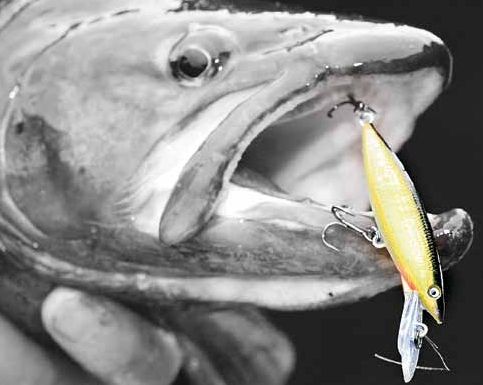
Presented from Issue 100
Considering the world class quality of our sea trout fishery, these fish are not sought after by enough anglers. Sea runners live in the salt water and run up our estuaries and rivers from the start of August to the middle of November. At this time of the year, they are here to eat the many species of fish that are either running up the rivers to spawn or are living in and around the estuary systems. Trout, both sea run and resident (Slob Trout) feed heavily on these small fish which darken in colouration as they move further into fresh water reaches.
The majority of these predatory fish are brown trout with rainbows making up a very small percentage of the catch. They can be found all around the state but it would be fair to say that the east coast is the least prolific of all the areas. They still run up such rivers as the Georges (and many others) but their numbers along with the quality of the fishing elsewhere make it difficult to recommend the area above the larger northern, southern and western rivers.
When to find the action
Timing your trip is extremely important. Although there is a small window of opportunity to catch them in April when they return to the rivers and estuaries to spawn, it is the first third of the season when the best action occurs.
A dry August followed by a wet September makes for ideal conditions as rain and therefore fresh in the rivers can bring the bigger fish out. Although dry conditions make fish easier to see and the white bait runs easier to follow, bigger fish will make up a smaller percentage of your daily catch. A small flood around September and October after the bait has started to run is perfect. Unless the river is in raging flood, it should still fish well. Unfortunately this year, it has been wet, wet, wet. The rains came earlier than we would have liked for excellent sea trout fishing but we often get a late run of fish and that is what I am counting on. Not to say the fishing hasn’t already been good but it will improve if the bait arrives in larger numbers.
Southern waters
By October we have usually seen the best of the Derwent, Huon and other southern estuaries. Fortunately, this spring has been very wet and the wonderful sight fishing associated with sea runners at the start of the season has not really happened. Yes, there has been some good fishing at times on the lower Derwent but it has been patchy.
The Huon was very poor early but bait has now shown up in reasonable numbers although often quite deep. Fish that have been caught in all of the southern rivers have had whitebait inside them but almost all of these fish have been caught underneath the fresh water in the salt pockets.
On the Derwent - just north of the Bridgewater Bridge has been the most consistent area although fish are still showing up chasing bait around Cornelian Bay and Old Beach. They are often very close in to shore. As usual, fast and accurate casts are needed. When there is not much bait around, the time between trout raids on bait schools can be lengthy. A bit more patience than normal is required but when you get a cast in the right place, the fish are more likely to take. Wind direction has never been a factor I have considered very much but of late, the calmer shore has made sighting the trout much easier. It may be due to the smaller numbers of bait fish present that has made for smaller explosions. For some reason, there have been an unusually high number of Atlantic Salmon coming to the fly in the first two months.
Although they usually make up a small percentage of fish caught, many fish around the five pound mark recently made up over fifty percent of the fish we caught on a recent trip to the Huon. I am not aware of an escape of salmon but they are there!
Although a boat opens up the rivers up to you, the Huon River and those to the south such as the Esperance, Lune and Kermandie, are all good places to look for sea runners through October even if you are shore based. If you are planning a trip to the D’Entrecasteaux and Catamaran River, a boat or canoe is a must.
Timing the tide
Picking the right stage of the tide during which to fish will directly influence your success. A strong out going tide is the best time to fish. The speed of the water running down the middle of the river forces the migrating bait to the edges where trout lie in ambush. The little fish use logs, rocks, bridge poles, eroded banks and anything else that breaks the current to hide from the strong flows and rest before continuing up river. Trout then use these same obstructions to hunt them down and surprise the schools as they rest.
The top and bottom of the tide are the quiet times as no flow allows the bait to move freely up the river and spread out across its width. A rising tide assists the bait in their quest to move up river and more importantly, brings in another fresh run of whitebait with every high tide. Big tides are therefore better than small tides, especially on the west coast where some rivers do not have a strong connection to the ocean.
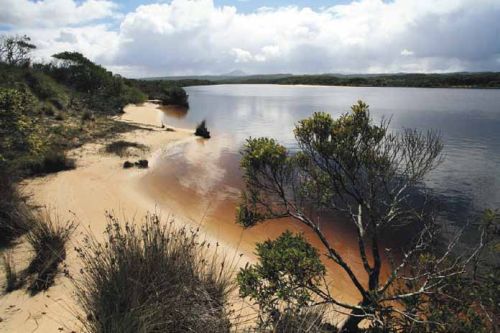 West coast
West coast
The west coast has some wonderful fishing around this time of year. The wild coast line has many tannin stained rivers with plenty of sea trout action from early October onwards. The Arthur and Pieman rivers have very limited walking access but boat fishermen can make the most of these spots. Reports from the Arthur River so far have not been good with extremely high water making fishing difficult with fly rods but those trolling and generally fishing deep have had more success. The fresh water current has been running flat out making it difficult to get anything deep enough in the flow. Further south near Strahan, the Gordon River is even more difficult to get to and a boat is essential. The mouth of the river is the major hot spot although casting under the over hanging trees is a reliable fall back.
The most productive rivers on the west coast are usually the Henty and Little Henty. Both of these rivers are north of Strahan and are hard to access more than a few kilometres upstream of where they empty into the sea. The walk to the Little Henty is very scenic but is hard to recommend due to the distance that is needed to be covered to reach the mouth.
The Henty itself is the most accessible of all west coast rivers. A boat ramp is located next to the highway bridge and four wheel drives can be driven to the sand dunes at the mouth where a camp site is located. Usually, low light levels are a bonus when chasing sea trout but during bright days, fish can be polaroided cruising over the white sand lip in spite of the tannin water. For those with boats, upstream from the launching ramp is also worth visiting.
Tides are very hard to predict on the west coast but if you are fortunate enough to make sure you are fishing here during large tides, the fishing will be far better. The bait seems to darken very quickly on the west coast and unless I am fishing the mouth of the river, dark olive and even black lures and flies work best. If you are planning a trip to this area, mid October is usually when it is at its best. Couple this with a big high tide and you should be salivating at the prospect.
Mersey and Forth rivers
The Mersey and Forth are the main sea run fisheries on the north west coast although fishing in almost every river emptying into Bass Straight can be good.
The Forth River mouth is a popular fishing location for those chasing others species but it produces its fair share of sea runners too. On the south side of the highway bridge trout are commonly seen along tussock lined banks and amongst the tea tree. A large weir used to cross the river south of the township of Forth. The area still fishes very well for sea trout and in fact has produced many fish already this season. The fishing in this river has been surprisingly consistent through the early months this season. Bait is there in good quantities and trout are feeding on them. Lures and flies with dark coloured tops and lighter underbellies have, and continue to be, the most successful.
I have not fished or heard many reports from the Mersey River this season. It did produce some very good fishing towards the start of the season but when the rain came, it shut down. At the time of writing this, it is running very high and filthy. There is no reason to think that it won’t produce as many fish as usual in October and November this season when the bait comes back. Not far from there in the Rubicon River, whitebait is certainly present.
North East rivers
The north east coast doesn’t get very much pressure from travelling anglers but the locals catch some wonderful fish and I will certainly be spending a few days here in the coming weeks. The Little Forester is difficult to access but well worth the effort. For those with kayaks, launching just short of the road bridge once you have driven through the town of Bridport is thing to do. Bait, runs well past this bridge in incredible numbers and after any prolonged dry period in October this will be the place to fish. The bank is over grown and hard to recommend above the Great Forester on the other side of Bridport. For the golf nuts, this river divides Barnbougle and the Lost Farm golf courses. It is narrow and exposed and very easy to fish from the bank. Many people make the long walk down to the river mouth but as is often the case, great fishing occurs at the road bridge. A bit of stealth is needed because fishing happens at close quarters and again, a falling tide is best. Trout activity can often be seen from the road bridge. There is a fish that consistently seems to feed under the small tea tree just north of the bridge at the mouth of the back water. I would love to see a photo of that fish if someone catches it - hopefully it is released. That fish drives me to insanity sometimes! The best fishing I have had at this time of year is often in the north east of the state.
Worth the effort
Those who do chase sea trout every year will agree that it is the highlight of the season. They are much harder fighting than those that only live in fresh water, are more elusive and equally frustrating. Of all forms of trout fishing, chasing these fish is more suited to the experienced angler than any other. The ability to repeatedly make good casts in exactly the right spot for hours will bring success. I don’t think I have ever seen one of these fish caught with a bad cast. The difficulty in catching them is part of the attraction because when you do, you know you have done everything right! Unlike the highlands in October and November, the weather at sea level is normally much warmer and more pleasant – another big plus.
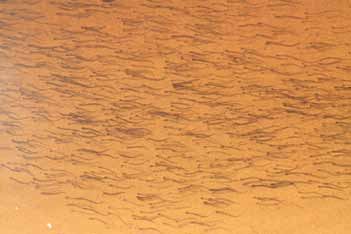 |
| Whitebait swimming along the edges. |
Fast and accurate casts are needed with bait fish patterns that at least resemble the rough shape and colouration of the natural prey. There is no need to fish ‘light’ and a ten to twelve pound flurocarbon tippet is standard. Five to seven weight rods are sufficient although when targeting big fish or when using sinking lines, the heavier option is more practical. The BMS in grey and olive is a very good fly in tannin water but I have found more life like patterns better in clear, saltier water. If you remember to fish darker flies further into the fresh water, you will be close to the mark.
For the lure angler, I have friends who catch them on mainly on Rapalas down deep and trolling the brown trout and rainbow trout patterns. This is particuIarly relevant on deeper rivers such as Derwent, Huon and west coast rivers including the Arthur and Henty.
Plenty of anglers also chase them using soft plastics and like fly fishers these anglers need to be accurate and consistent. There are some superb plastics for the job and these include Berkley minnows - pearl/watermelon; Gastronomics in a variety of colours; Squidgy Flick Bait in 70mm Evil Minnow or Pacific Pearl; Yep 3 inch Flick Bait in Whitebait or Pearl White.
The real advantage with soft plastics is being able to fish different depths without jig heads. It is simply a matter of letting the plastic drop for a few seconds and varying the retrieve.
Plastics can also be fished unweighted and this can be dealy at times when a fish is smashing into the bait/whitebait. Often they will smash at it — then come back and pick up the dmaged whitebait. If your plastic is slowly sinking and rolling around you are in with a chance. In this situation where you are basically fishing without retrieve it is important to watch the line for movement rather than feel. Strike if you see the line pull away.
If you are in a boat a Minn Kota bow mount is almost essential and is probably the most useful fishing accessory you can have. The new iPilot has a ‘spot lock’ feature that allows you to anchor via a GPS signal. It is awesome. Sea trout fishing has a level of excitement unmatched by other forms of fishing. They fight harder than any other trout, provide wonderful sight fishing, are often more accessible than their fresh water friends and grow to sizes not seen anywhere else in Tasmania. You don’t have much time to take advantage of them this season so get out there.
Christopher Bassano
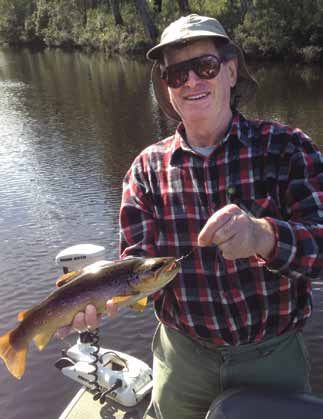
Accurate casting is essential and a Minn Kota keeps you close to the action.
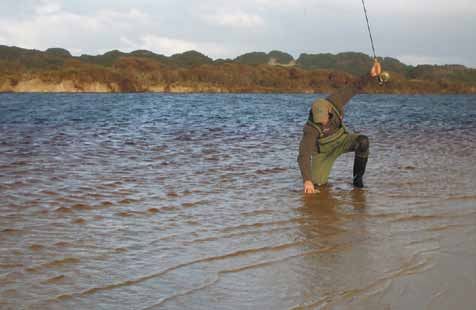
Shore based fishing can be fabulous for lure and fly fishers. The Derwent has great access at many areas.
The Little Henty, Henty and Great Forester have some good access points.
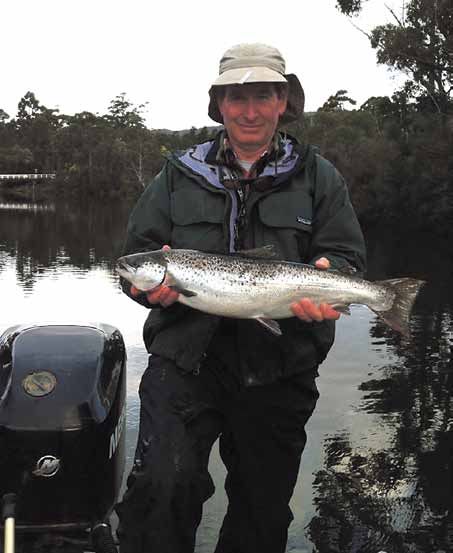
A delicious sized salmon.




